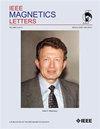利用机器学习设计的自旋波透镜的实验演示
IF 1.1
4区 物理与天体物理
Q4 ENGINEERING, ELECTRICAL & ELECTRONIC
引用次数: 6
摘要
在这封信中,我们介绍了一种类似于自旋波透镜的装置的设计和实验实现,即它将自旋波聚焦到指定的位置。透镜的结构与任何传统的透镜设计都不相似。这是一种由机器学习算法产生的非直觉模式。作为一种自旋波设计工具,我们使用了我们定制的微磁解算器SpinTorch,该解算器具有内置的自动梯度计算功能,可以通过时间执行自旋波传播的反向传播。训练本身是以钇铁石榴石(YIG)膜的饱和磁化强度作为可变参数进行的,目的是将自旋波引导到预定位置。我们在广泛使用的mumax$^{3}$微磁求解器中验证了该器件的操作,并通过实验实现。为了实现实验,我们开发了一种通过直接聚焦离子束(FIB)照射在YIG中创建有效饱和磁化景观的技术。这使我们能够快速将纳米级设计图案转移到YIG介质上,而无需通过蚀刻对材料进行图案化。我们提前测量了与FIB剂量水平相对应的有效饱和磁化强度,并使用该映射将设计的散射体转换为所需的剂量水平。我们的演示证明了工作流的概念,该工作流可用于实现具有复杂功能的更复杂的自旋波设备,例如,自旋波信号处理器或神经形态设备。本文章由计算机程序翻译,如有差异,请以英文原文为准。
Experimental Demonstration of a Spin-Wave Lens Designed With Machine Learning
In this letter, we present the design and experimental realization of a device that acts like a spin-wave lens i.e., it focuses spin waves to a specified location. The structure of the lens does not resemble any conventional lens design. It is a nonintuitive pattern produced by a machine-learning algorithm. As a spin-wave design tool, we used our custom micromagnetic solver SpinTorch, which has built-in automatic gradient calculation and can perform backpropagation through time for spin-wave propagation. The training itself is performed with the saturation magnetization of a yttrium-iron-garnet (YIG) film as a variable parameter, with the goal to guide spin waves to a predefined location. We verified the operation of the device in the widely used mumax
$^{3}$
求助全文
通过发布文献求助,成功后即可免费获取论文全文。
去求助
来源期刊

IEEE Magnetics Letters
PHYSICS, APPLIED-
CiteScore
2.40
自引率
0.00%
发文量
37
期刊介绍:
IEEE Magnetics Letters is a peer-reviewed, archival journal covering the physics and engineering of magnetism, magnetic materials, applied magnetics, design and application of magnetic devices, bio-magnetics, magneto-electronics, and spin electronics. IEEE Magnetics Letters publishes short, scholarly articles of substantial current interest.
IEEE Magnetics Letters is a hybrid Open Access (OA) journal. For a fee, authors have the option making their articles freely available to all, including non-subscribers. OA articles are identified as Open Access.
 求助内容:
求助内容: 应助结果提醒方式:
应助结果提醒方式:


